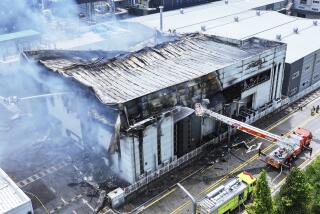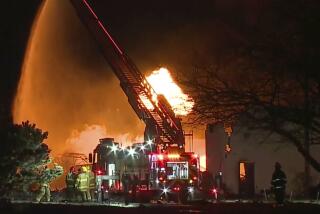Amid new explosions and fires at site of Chinese blasts, there is confusion over evacuation order
A new round of explosions and fires hit the Chinese port city of Tianjin on Saturday, pouring at least three plumes of black smoke into the sky, as confusion reigned over whether authorities had ordered the evacuation of a two-mile zone around the hazardous chemicals warehouse that exploded earlier in the week.
A 56-year-old man was rescued from a container just 150 feet from the blast site around 2 p.m. Saturday by hazmat teams, state-run China Central Television reported. Photos from the scene showed troops in camouflage protective gear and gas masks carrying the shirtless man to safety on a stretcher. He was later reported to be in stable condition.
Firefighters and hazmat teams have struggled to bring the situation in the Binhai New Area under control for days, and criticism is mounting over multiple aspects of the disaster. The death toll has risen to 104 people, with more than 700 injured. At least 21 firefighters have died. According to the People’s Daily, the identity of only 28 of the 104 victims could be immediately confirmed; DNA tests would be performed on the rest.
NEWSLETTER: Get the day’s top headlines from Times Editor Davan Maharaj >>
In yet another sign of confusion, the state-run Xinhua News Agency and other official media outlets reported at around 2 p.m. that authorities had ordered the evacuation of a two-mile zone around the blast site. But at a news conference three hours later, a Tianjin official denied there was any evacuation order, a denial that was later reported by People’s Daily and other official outlets. Yet journalists on the scene quoted locals as saying they had been told to evacuate.
A variety of toxic substances were believed to be stored at the site including potassium nitrate, ammonium nitrate, sodium cyanide and calcium carbide. Sodium cyanide has leaked into water seeping from the area, officials say, though measures were taken to block storm drains and other effluent routes.
According to the U.S. Centers for Disease Control and Prevention, sodium cyanide can release hydrogen cyanide gas, a highly toxic chemical asphyxiant that interferes with the body’s ability to use oxygen.
Exposure to sodium cyanide can be quickly fatal, the CDC says; hydrogen cyanide gas released by sodium cyanide has a distinctive odor described by some people as bitter almond or a musty “old sneakers smell,” but many people cannot detect it and the odor does not provide adequate warning of hazardous concentrations.
The operator of a chemical plant in Hebei province has come forward to say that his firm had delivered 700 tons of sodium cyanide to the warehouse where the blasts occurred, even though the warehouse was permitted to store only up to 10 tons of the hazardous material, the Science Daily and other news outlets reported. Authorities were amassing tons of hydrogen peroxide to neutralize the sodium cyanide.
Conflicting reports about evacuations and the appearance of hazmat squads on the scene added to fears about the health hazards for local residents. State-run television has shown footage of hazmat teams in gas masks and protective suits tromping through the disaster area, trying to determine what toxic substances were present, though these specialists apparently did not arrive on the scene until about 36 hours after the initial blasts late Wednesday night.
Meanwhile, family members of some emergency workers confronted Tianjin officials Saturday morning at a press conference. Some claimed that their relatives were contract employees – not full-fledged firefighters -- and have not been accounted for in the official death and injury tolls. Authorities denied that that was the case.
“I don’t know where my son is. I’ve no clues. If he is alive, I want to see him. If he is dead, I need to see his body,” Liu Huan told the state-run newspaper China Daily. Liu’s 22-year-old son, Liu Chuntao, was among the first group of firefighters sent to the scene.
Authorities had said the main fire was extinguished by 6 p.m. Friday night, according to Xinhua. So it was unclear why or how new explosions and fires were set off Saturday.
Video footage carried by state-run media showed at least one of the fires appeared to be several cars burning in a parking lot just south of the blast site. The vehicles were new cars awaiting shipment to dealerships around China and had already been damaged in the initial blasts.
Local fire officials said they had mobilized 66 forklifts, as well as cranes, excavators and armed police trucks to deal with the situation at the site, and had transported 600 tons of sand to the area that could be used to extinguish hot spots.
Authorities have called the complexity and scale of the accident unprecedented and say it’s the deadliest incident for firefighters since the founding of Communist China in 1949.
Neither President Xi Jinping nor Premiere Li Keqiang -- who is often dispatched to the site of major disasters -- has visited Tianjin yet. Xi on Saturday ordered officials to learn from the “extremely profound” lessons, which have been “paid for with blood.”
China, he said, needs greater accountability, better emergency response mechanisms, better implementation of work safety regulations, and careful checks of all possible safety risks.
The full economic toll of the incident has yet to be calculated, but Binhai district vice chief said Friday that 17,000 households and 1,700 businesses had been affected. Binhai accounts for 55% of Tianjin’s gross domestic product and posted growth of 15.5% last year, Xinhua reported – twice China’s overall growth rate.
Who would bear responsibility for paying for all the damage to business and residential properties remained unclear. China’s insurance regulator ordered insurers to prioritize claims from the incident.
Automobiles, information technology, aviation services, petroleum and chemical engineering are among the key sectors represented in Binhai. The centrally planned business, residential and industrial area rose from a swath of fields and small villages in recent years.
Automakers have reported significant disruptions to their activities in Tianjin. The port processes about 40% of China’s imported cars, Xinhua said.
Thousands of new cars awaiting shipment to dealerships were burnt to a crisp by Wednesday’s massive explosion.
Toyota said 50 members of its staff in the area were injured. Renault alone said it lost about 1,500 vehicles with a value of more than $30 million.
Sun Jiuwen, a professor of regional economy at Renmin University of China, said the immediate effect on Tianjin’s economy could be grave in the short term.
“Even if we put aside the direct losses, including casualties, cargoes and infrastructure damage, the tragedy will severely strike the local economy, which heavily relies on the chemical, port and logistics industries,” he told China Daily.
Follow @JulieMakLAT for news from China
ALSO:
‘Mama, save me, I can’t bear it’: A firefighter’s cry in China’s inferno
Chinese firefighters paid high price in blasts that water may have triggered
Nursing home fire kills at least 38 seniors in Henan, China
More to Read
Sign up for Essential California
The most important California stories and recommendations in your inbox every morning.
You may occasionally receive promotional content from the Los Angeles Times.











